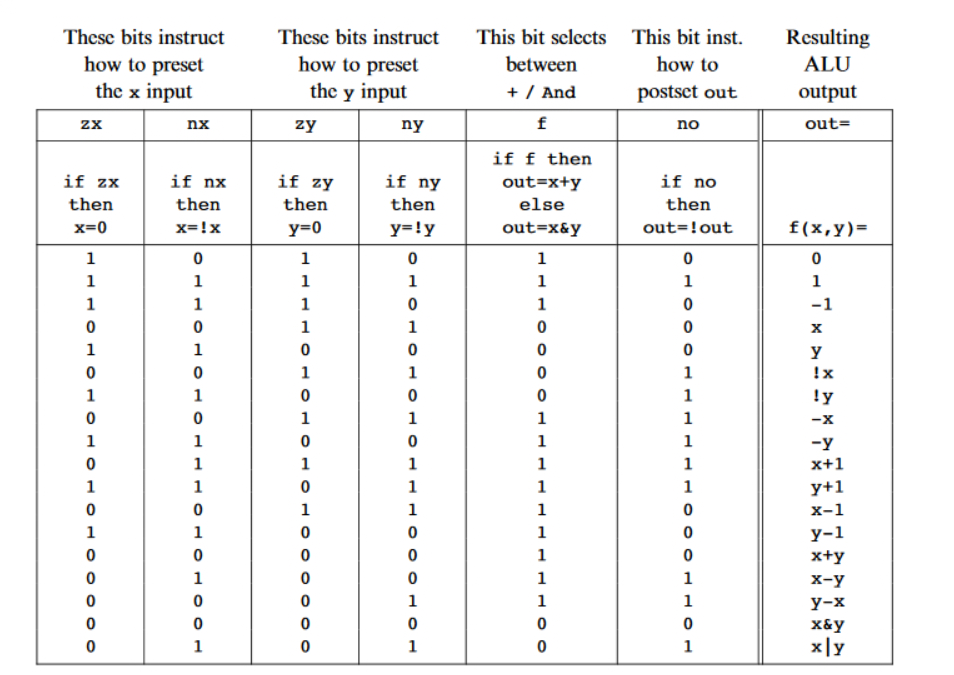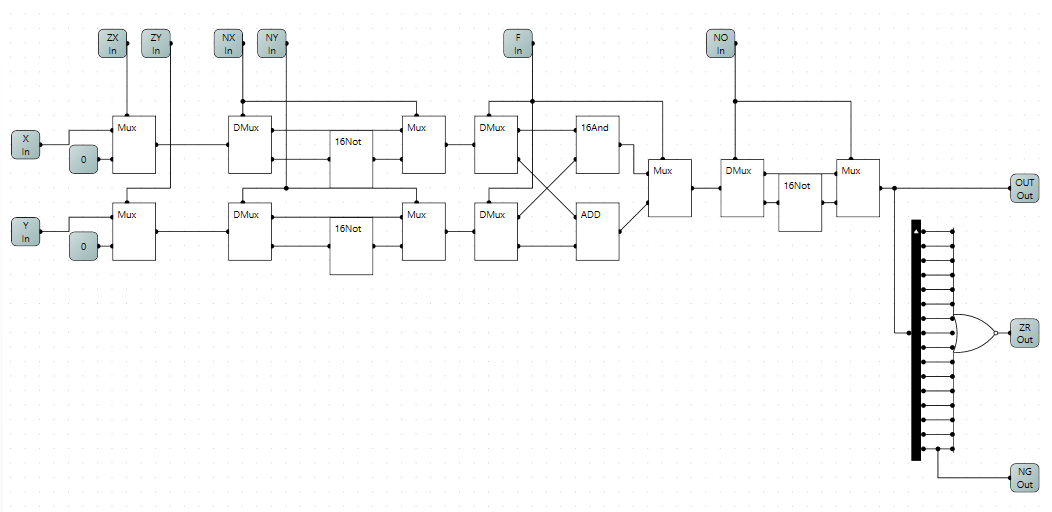ALU Arithmetic Logic Unit
1. ALU
The Hack ALU computes 18 possible functions on two 16-bit inputs (x, y), selected by 6 control bits. It outputs:
A 16-bit result (out).
Two status flags:
zr (Zero): 1 if out == 0, else 0.
ng (Negative): 1 if out < 0 (MSB = 1), else 0.

2. Truth Table

3. Implementation (Logisim)
Representation of the ALU in the logisim software using the previous gates. The ALU is built using:
Multiplexers (Mux16) for zeroing/negating inputs.
Add16 and And16 for arithmetic/logic operations.
Not16 for conditional negation.
Or16Way + Not for zero detection.

3.1 Control bits:
zx – essentially named as zerox – states whether x is 0 or not – if zx = true, then x = 0.
nx – essentially named as negationx – states whether x will undergo negation or not – if nx = true, then x will undergo negation.
zy – essentially named as zeroy – states whether y is 0 or not – if zy = true, then y = 0.
ny – essentially named as negationy – states whether y will undergo negation or not – if ny = true, then y will undergo negation.
f – essentially named as function – states whether addition or and function is selected – if f = true, then execute function x + y ; else x & y
no – essentially named as negationout – states whether output will undergo negaton or not – if no = true, then out will undergo negation.
3.2 Output bits:
While output bits other than out is not shown in the truth table, there are two output bits – zr & ng – other than out.
zr – essentially named as zero – states whether the final output is zero or not. – if out = 0; zr = true
ng – essentially named as negative – states whether the final output is negative or not. – if out = negative; ng = true
4. Implementation (HDL)
The ALU can be implemented using some of the gates we’ve learnt earlier.
CHIP ALU {
IN
x[16], y[16], // 16-bit inputs
zx, nx, zy, ny, // Input modifiers
f, no; // Function/Output modifiers
OUT
out[16], // 16-bit result
zr, ng; // Flags: zero/negative
PARTS:
// Preprocess X (zx, nx)
Mux16(a=x, b=false, sel=zx, out=zerox);
Not16(in=zerox, out=notx);
Mux16(a=zerox, b=notx, sel=nx, out=prex);
// Preprocess Y (zy, ny)
Mux16(a=y, b=false, sel=zy, out=zeroy);
Not16(in=zeroy, out=noty);
Mux16(a=zeroy, b=noty, sel=ny, out=prey);
// Compute f(x,y)
Add16(a=prex, b=prey, out=addxy); // x + y
And16(a=prex, b=prey, out=andxy); // x & y
Mux16(a=andxy, b=addxy, sel=f, out=fxy);
// Postprocess output (no)
Not16(in=fxy, out=notfxy);
Mux16(a=fxy, b=notfxy, sel=no, out=out, out[15]=ng, out[0..7]=zr1 , out[8..15]=zr2);
// Zero/negative flags
Or8Way(in=zr1, out=or1)
Or8Way(in=zr, out=or2)
Or(a=zr1 , b=zr2 , out=prezr)
Not(in=prezr, out=zr); // zr = 1 iff out == 0
}